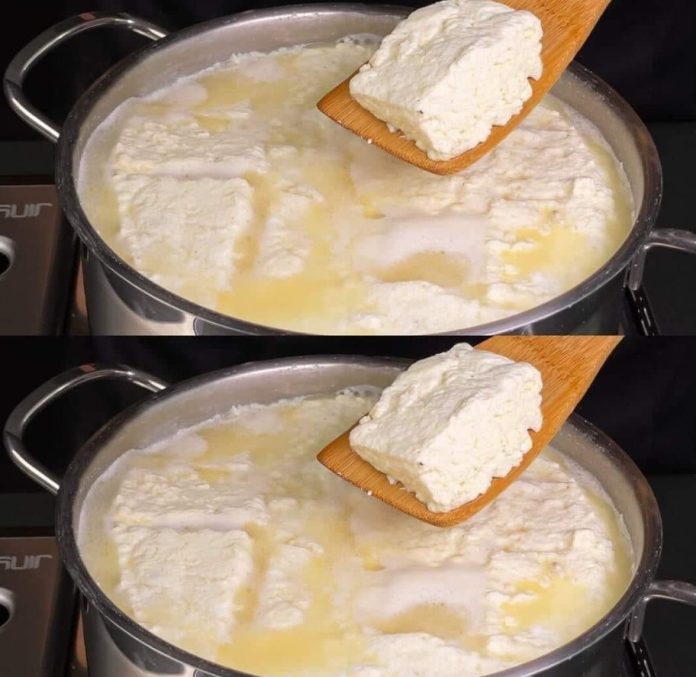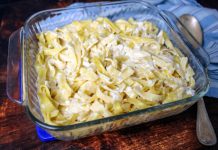There’s something truly magical about making cheese at home, a process that connects us to traditions passed down through generations. In a world filled with store-bought products, nothing beats the satisfaction of creating something from scratch.
This simple yet delightful three-ingredient cheese recipe, inspired by Grandma’s kitchen, allows you to experience the joy of homemade cheese without the complexity often associated with artisanal cheese-making. Let’s embark on this delicious journey together!
Ingredients :
To create your own batch of homemade cheese, you will need just three basic ingredients:
- Whole Milk (4 cups): The foundation of your cheese, whole milk provides the creaminess and rich flavor.
- White Vinegar or Lemon Juice (1/2 cup): This is your acid, which helps curdle the milk and separate it into curds and whey.
- Salt (1 teaspoon): Enhances flavor and helps in preservation.
Equipment Needed
- A large pot
- A thermometer
- A slotted spoon
- A cheesecloth or clean kitchen towel
- A colander
- A bowl for draining
Step-by-Step Instructions :
- Prepare Your Workspace: Start by ensuring that all your equipment is clean and sanitized. This will help you avoid unwanted bacteria and ensure a safe cheese-making process.
- Heat the Milk: Pour the whole milk into a large pot and slowly heat it over medium heat. Stir gently to prevent it from scorching. Use a thermometer to monitor the temperature; you want the milk to reach about 190°F (88°C).
- Add the Acid: Once the milk has reached the desired temperature, remove it from heat. Slowly add the white vinegar or lemon juice while stirring gently. You’ll notice the milk beginning to curdle—this is a sign that the acid is working its magic!
- Let It Rest: Allow the mixture to sit for about 10 minutes. This resting period helps the curds form fully and gives you a nice separation from the whey.
- Strain the Curds: Line your colander with cheesecloth or a clean kitchen towel. Carefully pour the curdled mixture into the colander, letting the whey drain away. Gather the corners of the cheesecloth and give it a gentle squeeze to remove excess moisture.
- Season Your Cheese: Transfer the curds to a bowl and add salt. Mix well, adjusting the seasoning to your taste. If you’d like to experiment, consider adding herbs, spices, or even garlic for a unique twist!
- Mold and Chill: For a firmer texture, you can press the curds into a mold. Alternatively, you can simply shape them into small balls or a log. Place the formed cheese in the refrigerator to chill for at least an hour before serving.
Enjoying Your Homemade Cheese
Now that you’ve created your very own cheese, the possibilities are endless! Use it in salads, spread it on bread, or enjoy it as a snack with crackers. Pair it with fruits and nuts for a charming cheese board, or melt it into your favorite dishes for a creamy finish.
The Benefits of Homemade Cheese
Making cheese at home not only allows you to enjoy fresher and healthier options, but it also provides a creative outlet. You can experiment with flavors, textures, and styles. Plus, there’s a deep sense of satisfaction in sharing something you’ve made with your own hands.
Conclusion :
Rediscovering the joy of homemade cheese with this simple three-ingredient recipe is more than just a culinary endeavor; it’s an experience steeped in tradition, creativity, and personal connection. Each step of the process invites you to slow down and savor the journey, transforming a few basic ingredients into a delightful creation that nourishes not only the body but also the spirit.
As you craft your cheese, think of the stories that accompany such a beloved tradition—of family gatherings, cozy kitchens, and shared meals. The act of making cheese can become a cherished ritual, a way to reconnect with loved ones or even to introduce the art of cheese-making to a new generation. Imagine teaching your children or grandchildren how to create something so fundamental, passing down knowledge and love alongside the recipe.
The beauty of homemade cheese lies in its versatility. With just a few tweaks—experimenting with different herbs, spices, or even infusions like garlic or chili—you can create a cheese that reflects your personal taste and the flavors of your local environment. Each batch can be a unique expression of your culinary style, allowing you to put your stamp on a time-honored tradition.
Moreover, making cheese at home encourages mindfulness and appreciation for the food we consume. In a world dominated by mass production, taking the time to create something from scratch fosters a deeper understanding of ingredients and their origins. You’ll find that the taste of your homemade cheese surpasses anything from a store, carrying with it the essence of your hard work and dedication.
So, as you slice into your fresh cheese, remember that this small act of creation is a celebration of life’s simple pleasures. Pair it with your favorite fruits and nuts, share it with friends over a glass of wine, or use it to elevate everyday dishes. Whatever you choose, each bite is a testament to your effort and a delicious reminder of the joy found in homemade creations. Embrace this experience, and let it inspire you to explore even more culinary adventures in your kitchen!
Source of the picture : Barbara O’Neill Lectures










